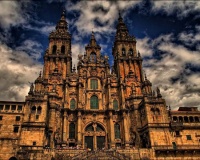Cathedral of Santiago de Compostela (1211 AD)
The End of the Journey for Pilgrims[edit]
When Aymeric Picaud published the fifth chapter of his Liber Sancti Jacobi in 1140, he may have struggled to believe that his text – widely regarded as the first travel guide ever written – would still form a point of reference for pilgrims on the Camino de Santiago some nine centuries later. Santiago de Compostela Cathedral, or Catedral de Santiago de Compostela, located in Galicia in north-western Spain, is the reputed burial place of the patron saint of Spain, St. James (Santiago). For more than 1,000 years the cathedral has been a place of pilgrimage – it is estimated that a quarter of all 14th century Europeans made the hazardous and debilitating journey. Today, pilgrims come from all corners of the planet – an estimated 150,000 made the trip last year – and their reasons for undertaking the pilgrimage are as varied as their nationalities. For many, the journey is a Christian pilgrimage, while for others it is purely spiritual, often made at a difficult juncture in someone’s life. Others treat it merely as a personal challenge, an opportunity to immerse themselves in Spanish history and culture, or simply as a chance to take in some of Europe’s most spectacular scenery. Generally, the journey itself is one of transcendence – an opportunity for people of disparate cultures to gain mutual understanding and spiritual growth.
